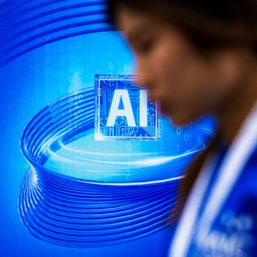SUMMARY
This is AI generated summarization, which may have errors. For context, always refer to the full article.

The foundation of the Philippine outsourcing industry is the population’s English language proficiency, the Filipino can-do attitude, and admittedly, the cheap cost of labor.
The industry contributes around $35 billion (around P2 trillion) to the Philippine economy annually. It is also the second largest source of foreign exchange, just behind overseas Filipino workers.
But this could all change as generative artificial intelligence (AI) is anticipated to wipe out millions of jobs worldwide.
For Jack Madrid, president of the Information Technology and Business Process Association of the Philippines (IBPAP), navigating the era of AI just takes optimism and adaptability.
“We are focused too much on the paranoia of job displacement so I think we need to just, you know, control. Let us deal with challenges that we can control. Rather than be fearful of AI, we need to accept it, embrace it. All the information is there,” Madrid said in an episode of Business Sense.
Outsourcing overview
The Philippines is the second largest workforce for the global offshoring industry, representing between 16-18% of the total market share by delivery geography, data from IBPAP showed. India remains to be the most dominant, between 38-40%. Central and Eastern European countries, including Northern Ireland,also have a strong presence, with as much as 20% of the total share.
While India has over 4 million people employed in outsourcing, the industry just comprises around 4% of gross domestic product (GDP). The Philippines has a larger exposure, as outsourcing comprises around 8% of GDP.
North America is the biggest adopter of offshore services, comprising as much as 41% of the total share. Europe and Asia-Pacific are also big adopters of outsourcing services at 35% and 16%, respectively.
Most outsourcing jobs are in the banking and financial services sector, followed by tech and media, retail, and healthcare.
There are currently around 1.5 million Filipinos in the IT-BPM industry. The industry is constantly being supplied by university graduates, which number around 850,000 per year.
As of end-2022, IT-BPM revenues reached $33 billion.
According to IBPAP, the Philippines is attractive for Western countries looking to outsource some of their jobs, as they save as much as 70% over their US and European counterparts.
Job displacement
A recently published discussion paper by the International Monetary Fund (IMF) likened the rise of AI to the next industrial revolution.
According to the paper, nearly 40% of jobs worldwide are affected by AI, putting developed economies more at risk than emerging and developing nations. Because jobs that involve cognitive tasks are so common in advanced economies, artificial intelligence is used in about 60% of jobs.
The percentage of total exposure is 40% in developing economies like the Philippines and 26% in low-income nations.
Consulting and outsourcing company Accenture estimated that 40% of working hours could be impacted by large language models (LLMs) like ChatGPT-4, as “language tasks account for 62% of the total time employees work.”
“Two things make LLMs game changing. First, they’ve cracked the code on language complexity. Now, for the first time, machines can learn language, context, and intent and be independently generative and creative. Second, after being pre-trained on vast quantities of data (text, images, or audio), these models can be adapted or fine-tuned for a wide range of tasks,” Accenture said.
IMF researchers, however, noted that those with higher exposure to AI are also better positioned to take advantage of AI’s predominance. The issue, however, is that not all may be able to seize opportunities.
“Although many emerging markets and developing economies may experience less immediate AI-related disruptions, they are also less ready to seize AI’s advantages. This could exacerbate the digital divide and cross-country income disparity,” IMF researchers said.
AI will also affect income and wealth inequality. IMF noted that unlike previous waves of automation, which had the strongest effect on middle-skilled workers, AI displacement risks extend to higher-wage earners.
“[H]igher-wage earners can expect a more-than-proportional increase in their labor income, leading to an increase in labor income inequality. This would amplify the increase in income and wealth inequality that results from enhanced capital returns that accrue to high earners,” researchers said.
The IMF researchers said developing a workforce with digital skills and laying the groundwork for infrastructure development are critical for developing and emerging markets that are less developed. Social safety nets and retraining for workers who are susceptible to AI are essential for ensuring inclusivity in all economies.
New jobs
As some jobs disappear in the age of AI, new jobs are set to emerge.
The most prominent emerging roles, according to the World Economic Forum’s (WEF) Future of Jobs Report, are those in digital transformation, data analysis and science, and artificial intelligence and machine learning.
By 2027, the WEF projects a 40% increase in the number of experts in artificial intelligence and machine learning, a 30–35% increase in the demand for positions like big data specialists and data analysts, and a 31% increase in the demand for information security analysts. Together, these would create 2.6 million new jobs.
To harness the potential of AI, IBPAP and its members crafted a roadmap to upskill their workforce and future employees.
Soft skills like English proficiency and interpersonal communication are still important, but workers would need to learn about data science, internet of things, cloud operations, business analytics, and blockchain technology.
Those engaged in contact center and business processes will need to learn automation and data analytics, as well as new accounting tools.
“It is clear that the nature of work will change considerably. Further automation will significantly reduce the transactional tasks, freeing up resources to focus on high value-add services,” IBPAP said.
IBPAP has set ambitious growth targets amid the threats. It aims to grow the outsourcing industry to a $59-billion industry by 2028, with 2.5 million workers.
“I think an attitudinal thing for us is to just accept new technology, and we’ve done it in the past. We were the text messaging capital of the world. Some years back, we embraced it. Why can’t we embrace AI in the same way?” Madrid asked. – Rappler.com
Add a comment
How does this make you feel?




![[Good Business] Humanistic national development in the era of AI](https://www.rappler.com/tachyon/2024/06/tl-humanistic-development-of-AI.jpg?resize=257%2C257&crop=284px%2C0px%2C720px%2C720px)






There are no comments yet. Add your comment to start the conversation.